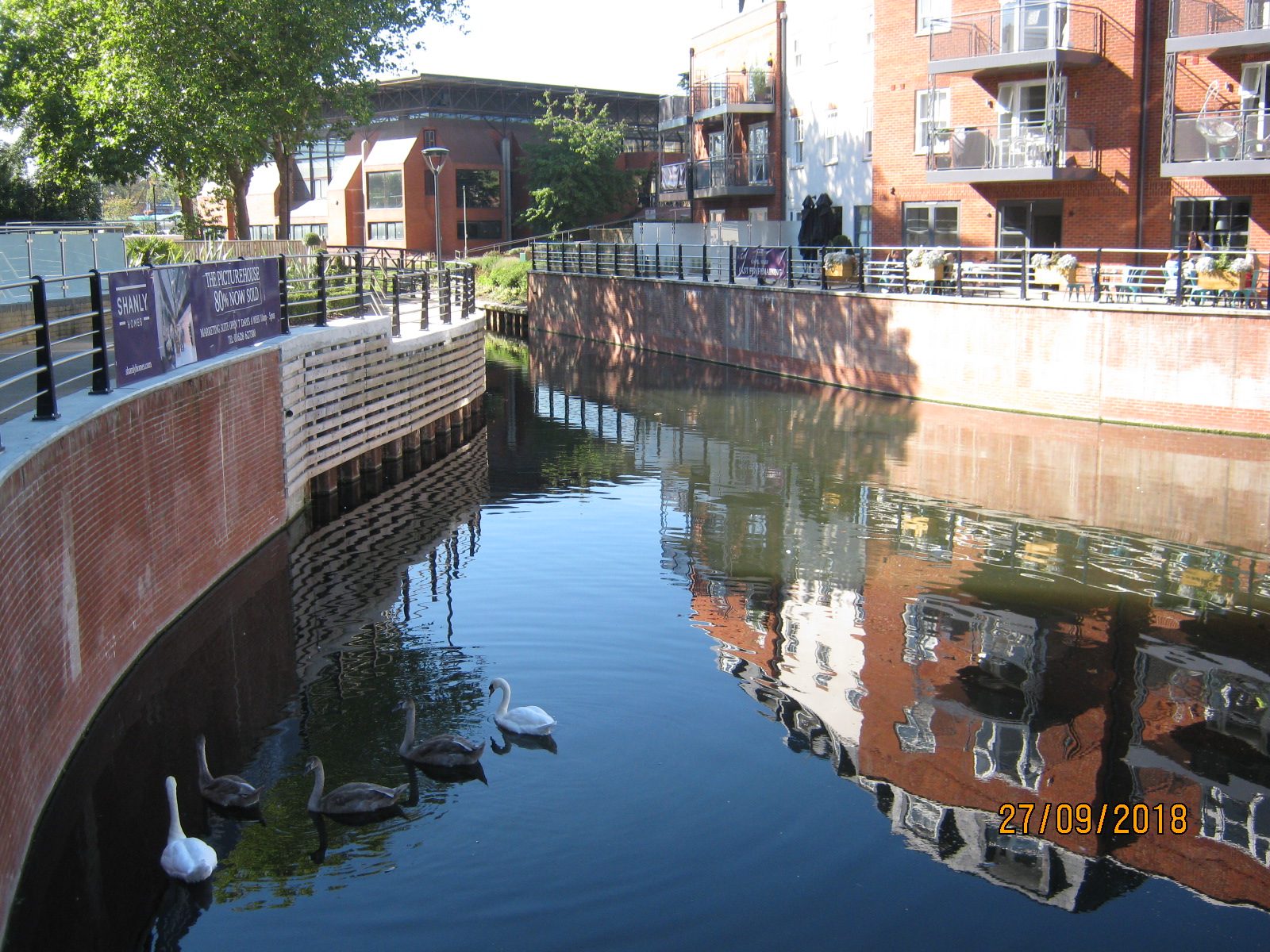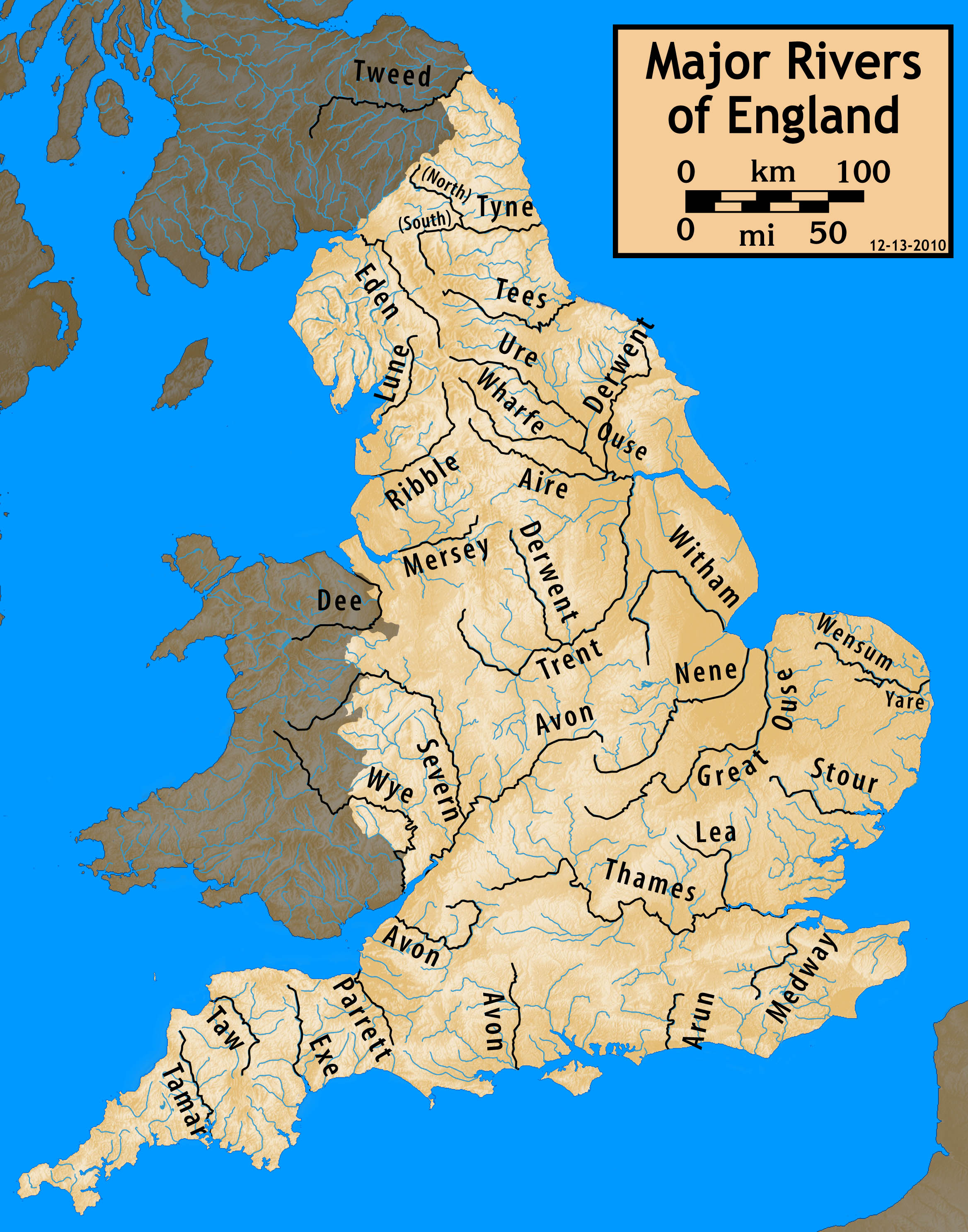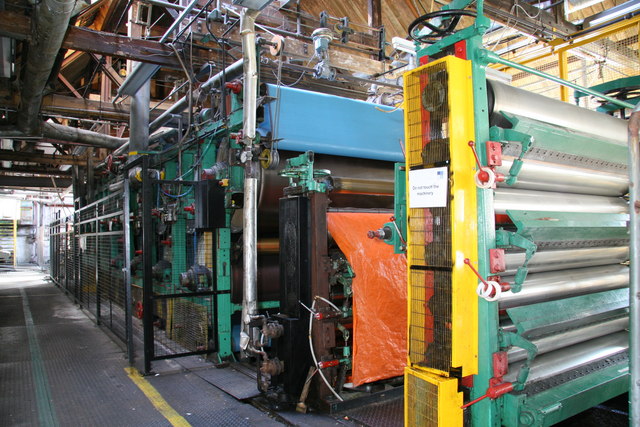|
River Wye, Buckinghamshire
The River Wye is a river in Buckinghamshire, England. Around in length, it rises close to West Wycombe village in the Chiltern Hills and flows through High Wycombe before emptying into the River Thames at Bourne End, on the reach above Cookham Lock. In particularly wet years, the source can temporarily change and effectively extend the river by another mile, due to a chalk spring rising above the ground in a field further up the same valley. High Wycombe takes part of its name from the river, which now runs mostly underground through the town. Pann Mill watermill, at the eastern end of Wycombe, is the last remaining watermill on the River Wye. History There is a long history of water-mills being operated in the Wye Valley which drops about in its course. The Domesday Book records eighteen of them in the nine miles between West Wycombe and the Thames. By the seventeenth century there were fulling mills as well as corn mills. A Court of Survey in 1627 lists six mills runni ... [...More Info...] [...Related Items...] OR: [Wikipedia] [Google] [Baidu] |
Wooburn
Wooburn is a large village in Buckinghamshire, England. It is located off the A4094 road between Wooburn Green and Bourne End in the very south of the county near the River Thames, about two miles south west of Beaconsfield and four miles east of Marlow. Wooburn is one of the two principal settlements within Wooburn, a civil parish in Wycombe district. The village toponym is derived from the Old English for "walled stream". This refers to the River Wye, which has its source near West Wycombe and runs through the village to join the River Thames at Bourne End. The river runs along the boundary of Warren Nature Reserve, a Local Nature Reserve which adjoins Wooburn Park. In the Domesday Book of 1086 the village was recorded as ''Waborne'' though earlier, in 1075, it had been referred to as ''Waburna''. The Church of England parish church of Saint Paul is medieval but was extensively altered by the Gothic Revival architect William Butterfield in 1869. It has a flint nave and a t ... [...More Info...] [...Related Items...] OR: [Wikipedia] [Google] [Baidu] |
Paper Mill
A paper mill is a factory devoted to making paper from vegetable fibres such as wood pulp, old rags, and other ingredients. Prior to the invention and adoption of the Fourdrinier machine and other types of paper machine that use an endless belt, all paper in a paper mill was made by hand, one sheet at a time, by specialized laborers. History Historical investigations into the origin of the paper mill are complicated by differing definitions and loose terminology from modern authors: Many modern scholars use the term to refer indiscriminately to all kinds of mills, whether powered by humans, by animals or by water. Their propensity to refer to any ancient paper manufacturing center as a "mill", without further specifying its exact power source, has increased the difficulty of identifying the particularly efficient and historically important water-powered type. Human and animal-powered mills The use of human and animal powered mills was known to Muslim and Chinese paperma ... [...More Info...] [...Related Items...] OR: [Wikipedia] [Google] [Baidu] |
Rivers Of Buckinghamshire
A river is a natural flowing watercourse, usually freshwater, flowing towards an ocean, sea, lake or another river. In some cases, a river flows into the ground and becomes dry at the end of its course without reaching another body of water. Small rivers can be referred to using names such as creek, brook, rivulet, and rill. There are no official definitions for the generic term river as applied to geographic features, although in some countries or communities a stream is defined by its size. Many names for small rivers are specific to geographic location; examples are "run" in some parts of the United States, "burn" in Scotland and northeast England, and "beck" in northern England. Sometimes a river is defined as being larger than a creek, but not always: the language is vague. Rivers are part of the water cycle. Water generally collects in a river from precipitation through a drainage basin from surface runoff and other sources such as groundwater recharge, spring ... [...More Info...] [...Related Items...] OR: [Wikipedia] [Google] [Baidu] |
Maidenhead Waterways
The Maidenhead Waterways are a system of canals in Maidenhead, England. Formerly disused, plans to restore and upgrade them were announced in 2011. The works would initially make the waterways navigable by small craft, and over time by larger craft, as limitations to navigation are gradually removed. Running south from the Thames near Cliveden, the channel divides into York Stream - passing under the historic Chapel Arches - and Moor Cut which crosses Town Moor. The channels re-join at Green Lane where they become Bray Cut, before returning to the Thames by Bray Marina. As a side channel of the Thames, the waterway has a perpetual right of public navigation, which cannot be extinguished by lack of use. History The flood plain between Cookham and Windsor has the remains of many old waterways, serving over time as boundaries, drainage channels, mill leats and in parts, for navigation. The waterways that still run through Maidenhead town centre were in the past much larger than ... [...More Info...] [...Related Items...] OR: [Wikipedia] [Google] [Baidu] |
Hennerton Backwater
Hennerton Backwater is a narrow backwater of the River Thames on the reach above Marsh Lock near the villages of Shiplake, Oxfordshire and Wargrave, Berkshire. Hennerton Backwater leaves the River Thames at the Unnamed Eyot, passing through Willow Marina, and rejoins just below Ferry Eyot. It is navigable by small boats from the downstream end for much of its length, but the bridge carrying Willow Lane over its upstream end has very limited clearance restricting passage to canoes and small dinghies even under favourable conditions. The island formed by the backwater and the Thames comprises Wargrave Marsh (now mostly drained) and Lashbrook Eyot (no longer distinct), and contains housing, farmland, and the premises of Henley Sailing Club. See also *Tributaries of the River Thames This article lists the tributaries of the River Thames from the sea to the source, in England. There are also secondary lists of backwaters of the river itself and the waterways branching off. ... [...More Info...] [...Related Items...] OR: [Wikipedia] [Google] [Baidu] |
List Of Rivers Of England
This is a list of rivers of England, organised geographically and taken anti-clockwise around the English coast where the various rivers discharge into the surrounding seas, from the Solway Firth on the Scottish border to the Welsh Dee on the Welsh border, and again from the Wye on the Welsh border anti-clockwise to the Tweed on the Scottish border. Tributaries are listed down the page in an upstream direction, i.e. the first tributary listed is closest to the sea, and tributaries of tributaries are treated similarly. Thus, in the first catchment below, the River Sark is the lowermost tributary of the Border Esk and the Hether Burn is the lowermost tributary of the River Lyne. The main stem (or principal) river of a catchment is labelled as (MS), left-bank tributaries are indicated by (L), right-bank tributaries by (R). Note that in general usage, the 'left (or right) bank of a river' refers to the left (or right) hand bank, as seen when looking downstream. Where a named river ... [...More Info...] [...Related Items...] OR: [Wikipedia] [Google] [Baidu] |
Tributaries Of The River Thames
This article lists the tributaries of the River Thames from the sea to the source, in England. There are also secondary lists of backwaters of the river itself and the waterways branching off. Note: the River Medway shares the saline lower Thames Estuary. Tributaries The average discharge is taken from the lowest point at which measurements are taken, which may be upstream of the confluence. Backwaters and cuts This list comprises the principal instances; longest ex-mill races (leats), with own articles are included; the main weirstream/river stream of each Thames lock is omitted and the smallest such associated instances but the Sheepwash Channel is included for its importance in Oxford. Linked waterways Poem by Alexander Pope listing some Thames tributaries See also *Locks and weirs on the River Thames *Islands in the River Thames References * Cove-Smith, Chris (2006). ''The River Thames Book''. Imray Laurie Norie and Wilson. {{ISBN, 0-85288-892-9. * Fred. S. T ... [...More Info...] [...Related Items...] OR: [Wikipedia] [Google] [Baidu] |
Tasmania
) , nickname = , image_map = Tasmania in Australia.svg , map_caption = Location of Tasmania in AustraliaCoordinates: , subdivision_type = Country , subdivision_name = Australia , established_title = Before federation , established_date = Colony of Tasmania , established_title2 = Federation , established_date2 = 1 January 1901 , named_for = Abel Tasman , demonym = , capital = Hobart , largest_city = capital , coordinates = , admin_center = 29 local government areas , admin_center_type = Administration , leader_title1 = Monarch , leader_name1 = Charles III , leader_title2 = Governor , leader_name2 ... [...More Info...] [...Related Items...] OR: [Wikipedia] [Google] [Baidu] |
Penal Transportation
Penal transportation or transportation was the relocation of convicted criminals, or other persons regarded as undesirable, to a distant place, often a colony, for a specified term; later, specifically established penal colonies became their destination. While the prisoners may have been released once the sentences were served, they generally did not have the resources to return home. Origin and implementation Banishment or forced exile from a polity or society has been used as a punishment since at least the 5th century BC in Ancient Greece. The practice of penal transportation reached its height in the British Empire during the 18th and 19th centuries. Transportation removed the offender from society, mostly permanently, but was seen as more merciful than capital punishment. This method was used for criminals, debtors, military prisoners, and political prisoners. Penal transportation was also used as a method of colonization. For example, from the earliest days of English ... [...More Info...] [...Related Items...] OR: [Wikipedia] [Google] [Baidu] |
Lancashire
Lancashire ( , ; abbreviated Lancs) is the name of a historic county, ceremonial county, and non-metropolitan county in North West England. The boundaries of these three areas differ significantly. The non-metropolitan county of Lancashire was created by the Local Government Act 1972. It is administered by Lancashire County Council, based in Preston, and twelve district councils. Although Lancaster is still considered the county town, Preston is the administrative centre of the non-metropolitan county. The ceremonial county has the same boundaries except that it also includes Blackpool and Blackburn with Darwen, which are unitary authorities. The historic county of Lancashire is larger and includes the cities of Manchester and Liverpool as well as the Furness and Cartmel peninsulas, but excludes Bowland area of the West Riding of Yorkshire transferred to the non-metropolitan county in 1974 History Before the county During Roman times the area was part of the Bri ... [...More Info...] [...Related Items...] OR: [Wikipedia] [Google] [Baidu] |
Frogmore Paper Mill
Frogmore Paper Mill is a working paper mill situated in Apsley, Hertfordshire, near Hemel Hempstead. The mill is on an island in the River Gade, which forms part of the Grand Union Canal. It is the oldest mechanical paper mill in the world. History There are no surviving records documenting when a mill was first built on the current site, but it is recorded as being a corn mill in 1086 in the Domesday Book. In 1289, the mill was used for fulling; removing oil and other impurities from woolen cloth. It returned to milling grain, then became a fulling mill once more, then finally it become a paper mill by 1774. The world's first mechanised paper machine was installed at Frogmore Mill in 1803 funded by Sealy and Henry Fourdrinier and engineered by Bryan Donkin, based upon a design by Nicolas-Louis Robert. This machine allowed continuous automated production of paper rolls. Unfortunately the £60,000 costs of developing the paper machines meant that the Fourdrinier brothers were b ... [...More Info...] [...Related Items...] OR: [Wikipedia] [Google] [Baidu] |
Fourdrinier Machine
A paper machine (or paper-making machine) is an industrial machine which is used in the pulp and paper industry to create paper in large quantities at high speed. Modern paper-making machines are based on the principles of the Fourdrinier Machine, which uses a moving woven mesh to create a continuous paper web by filtering out the fibres held in a paper stock and producing a continuously moving wet mat of fibre. This is dried in the machine to produce a strong paper web. The basic process is an industrialised version of the historical process of hand paper-making, which could not satisfy the demands of developing modern society for large quantities of a printing and writing substrate. The first modern paper machine was invented by Louis-Nicolas Robert in France in 1799, and an improved version patented in Britain by Henry and Sealy Fourdrinier in 1806. The same process is used to produce paperboard on a paperboard machine. Process sections Paper machines usually have at leas ... [...More Info...] [...Related Items...] OR: [Wikipedia] [Google] [Baidu] |







